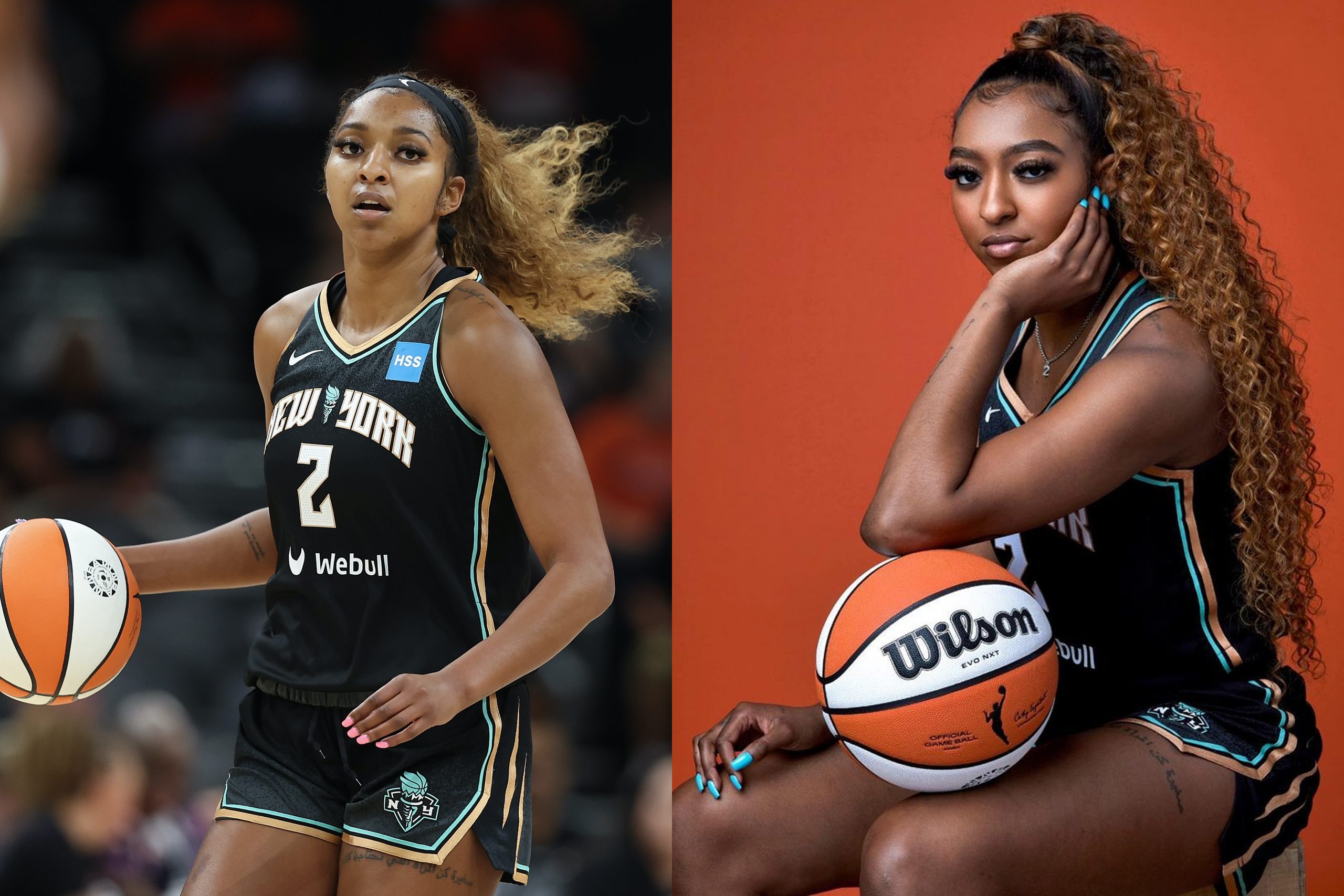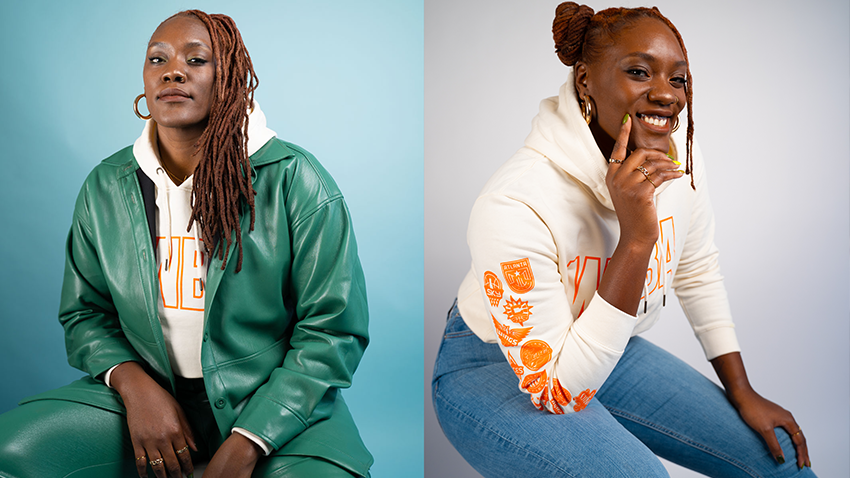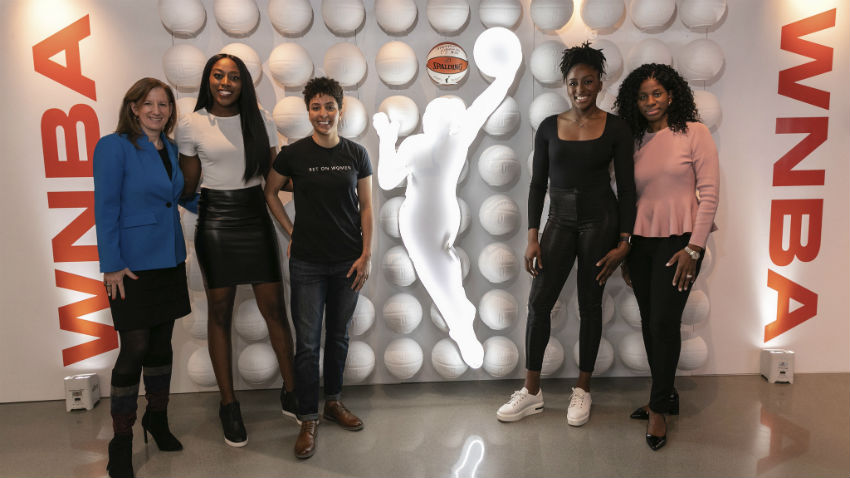The W in Designer: Roman King's Eye on the Future of the WNBA


Joining the league in 2019, King extends the league’s culture through creative direction.
Looking at the visual elements of the 2023 WNBA Draft, fans will notice new colors, tag lines, and displays that shape the energy of the upcoming season. Apart from experiential events, the league’s internal creative team is responsible for television, digital, print, content, and other fan-facing visuals. Led by Roman King, who’s served as creative director since 2019, the WNBA’s identity exists in a new, younger era that’s designed to be as fluid as its surrounding culture.
The culture around women’s basketball is an evolving, fast-paced idea that’s highly influenced by King and his team, as well as the current players of each season. There are also external factors that shape the culture, like rising women’s basketball-focused brands, breakthrough news, ongoing legacies, powerful social movements, and, of course, the fan response.
A self-proclaimed social anthropologist, King reveals that he finds the greatest inspiration in simply observing people and trends. His creative approach starts with really seeing and understanding the league’s players before placing spotlights on these women, as not only players but also as dynamic, off-court individuals. With an editorial background and natural style, as seen in King’s eye-catching suit collection, his work in elevating the league aligns with an overall, player-driven movement of strong personal brands, influencer-like opportunities, and pushing the athlete’s image.
While King handles the league’s biggest storytelling moments and season-long campaigns, he’s equally focused on capturing the individual stories and styles of the players. “If you’re not currently connected to any of the women in the WNBA, there’s 144 of them,” says King, “and they’re all different, dynamic and there’s someone for you to relate to.” Before the season starts, King sits down for an interview about what drives his visionary approach and the new energy his team is cultivating.

Kirsten Chen: You’ve worked with the WNBA for the last four years. What initially drew you to the league?
Roman King: I launched the rebrand in April of 2019, and I started in that same year. I came in when the WNBA was going through the evolution or reset, as we like to phrase it. I saw an amazing opportunity to be part of a monumental moment for the longest-standing women’s professional sports league. Like, how many opportunities do you have as a creative individual to help shape that? I always say, ‘This is not a job for me.’ It’s something that I believe in. It keeps me up at night, making sure that the work we’re building is representative of the women. They deserve it, they deserve all of the flowers. I’m so thankful that, finally, the WNBA is getting the recognition, viewership numbers, and following that has been long deserved for us.
KC: To give context for newer fans, can you summarize the rebrand?
RK: We were marketing to an audience as part of this rebrand that was indicative of the women of the WNBA: think of multicultural, urban, Gen-Z, and millennial types, a younger generation of fans and fans that weren’t necessarily avid basketball fans. We’re also marketing to individuals. You know, WNBA Pride is a platform, and these marginalized groups were part of the attention of the reset. The players had to feel seen, and that’s why the logo was relaunched. The logo is meant to be everyone, and the women of the WNBA are supposed to really see themselves in the logo.

KC: Can you expand upon the creative decisions behind the revamped logo?
RK: The logo was intentionally broken from her confines, so there’s direction with her being free. She’s free from the box, and by way of that, the WNBA is also free from its box and constraints. The WNBA also has 12 colors, most people really resonate with that orange, but we have magentas, purples, blues, and pastel colors. This is the fluidity of the younger generation, these are things for them to be excited by. They have an element of vibrancy. The rebrand work is meant to be very flexible. We need to be able to be agile and fluid with culture. Our design principles speak to a lot of that work.
KC: It sounds like the players have an influence on the league’s creative identity. Do you think the league’s identity changes from season to season?
RK: I think this probably harkens back to the rebrand work. There was so much in flexibility and fluidity as the brand principles of the WNBA. We have our core foundation and what we stand for as a league, and those will never really change. I’d say our voice and tonality, it’s not gonna shift. But, what’s really important is to ebb and flow with culture. As culture moves, the WNBA will naturally move. We’re a brand that’s about making space, making the women of the league stars, and building household names. The WNBA as a product isn’t just a basketball game, even though that’s the entrée. There’s so many garnishes with this league. I think the WNBA will continue to evolve and grow as the generations of the WNBA players change and shift.

KC: What are some fan-facing visuals or projects that your team has worked on? Is there anything you’re most proud of?
RK: There was the 25th anniversary “Count It” that’s fun. A double entendre of counting all of the accomplishments over 25 years and making it sure that the public was aware of everything we’re doing. I think there wasn’t much awareness of how much of a trendsetter this league had been, so “Count It” was the tagline.
This past year, one of my favorite projects was a short film called “We Are the W,” an off-court piece. It’s about humanizing the women in the WNBA. Sometimes, there’s not enough awareness of who they are as individuals. That was a great storytelling piece around Angel McCoughtry, Isabelle Harrison, and DiDi Richards. It was extrapolating the on-court, and it was all off-court: DiDi’s being paralyzed in college; Angel trying to make her comeback after an injury and what’s that like when you’re in your mid-thirties; and Isabelle, who’s such a community leader, but no one knows that she comes from this giant sports family. Projects, where I get to really focus on the women and the external face of the league, are always the real passions of mine.
Another was the Red Hooks Labs in 2019, where it was about the women as individuals and their individual style. It was also a piece where I hired young, multicultural photographers to shoot nine powerful Black women in the WNBA. It was their first time being seen in that way. Again, the opportunities I have to broaden the scope and make people think differently about how this league is perceived are my favorite projects.

KC: How does your editorial background shape your approach to working with the W?
RK: My editorial background shapes [me] into thinking about things in multi-layers, multi-platform, and different stories, like in a magazine. In that industry, you can’t retell the same story twice. Our job is to bring newness to the forefront and to think in a visual way, to get you to think a bit differently. There would be something in a magazine, but it would translate differently for social or .com or an event. I’m very passionate about events, but those are different avenues of how you could approach a story. You don’t approach ’em all the same, like something on Instagram the same way you’d approach it on TikTok.
KC: Tell us about planning for this year’s draft event.
RK: Coming into the WNBA, I try to empower my team to think about things in different ways and to not redo what we’ve done last year. The WNBA draft is an experiential event, but it’s also a broadcast event. Then, it’s social and other layers and appendages. They shouldn’t be approached the same way. This year was like, ‘How do we take what we’ve done and elevate it?’ Last year was the first time we were at Spring Studios, which is a mecca for fashion in New York City. It’s the home of New York Fashion Week. I made a very conscious choice and had supportive leadership to take draft there. That was a non-traditional space for us to be in. You can see last year, and then, this year as its evolution, it works. We fit in these spaces, the WNBA is fashion. So, those influencers who attend draft, who are not necessarily avid basketball fans, they’re part of our demographic, and there’s something for them to connect to. I love evolving what we’re doing.

KC: Looking at the upcoming season, is there anything you’re focusing on?
RK: We’re seeing our most viewership in 19 years and our most views on socials ever. There’s a keyword here, “more,” and this upcoming year, we’re going to try and give you more moments and more culture. Last year, we had our commercial campaign, “More Than Incredible,” which was soundtracked to Alicia Keys and Lil Wayne. It was hip-hop. I could tease that hip-hop and culture is super important to this league, and indicative of the direction that we’re going. WNBA All-Star is going to be in Las Vegas, we’re trying to make everything ‘more’ and bigger than it’s ever been.
KC: When creating new ideas for the WNBA, where do you look for inspiration?
RK: I would call myself a bit of an anthropologist, where you study people? I think it’s why I’m so passionate about my job because its about people, it’s about players and it’s about a league of people. I love observing people, like ‘What’s going on? Where are people going out?’ I have the pleasure of living in New York City, which is the mecca of everything happening. I think trends start here, so it’s a lot of being in public and seeing what people are resonating with, maybe what other brands are doing, and the public, online on .com or socials.
I’m very big on scrolling, my finger hurts from scrolling. Instagram is my favorite platform, followed by TikTok. Instagram is like a mood board to me, a lot of my research probably starts there and from what others are doing. I’m a big coffee table and photobook person, and because I worked in magazines, I have a lot of magazines, paper, and print– I think anyone who worked in magazines are like hoarders– I will always be that person. Lastly, I’m a TV junkie. When I’m not working, I’m watching what’s trending on Twitter, I’m seeing what’s on TV. It’s important to stay connected to culture and what people are chatting about. It’s almost like homework for me to make sure I’m staying tapped into what’s happening.
KC: As the creative director of the W, what does success look like to you?
RK: At the end of the day, if we have people talking about what we’re doing, I think that’s success. We’re seeing the numbers from viewership and engagement on social, and I hope that’ll continue to trend. We want people to be engaged with the content and creative in the visuals that are coming out of our league. If I can get some conversation started, that’s success to me. Creative is often hard to traditionally measure because it can be subjective, it’s not something you can objectively measure that it performed well.
But, the draft for instance, which has a lot of creative attached to it, a lot of its new direction stemmed from a creative approach. It translated on the viewership, social metrics, and everything. It was a direction to take it somewhere different, and you can’t really measure that traditionally. I’d say anytime someone is talking, if there’s any chatter about what we’re doing, that’s always a success to me. Again, we want people to be thinking and responding to what we’re doing.

KC: What do you think is the impact of players developing their own strong images?
RK: Oh my gosh. We are living in a generation. What excited me is that the players are now conscious and cognizant that they have an image outside of the game. I would encourage any female athlete to think about their brand because they are brands, at the end of the day. People can look at our own draft and the incoming ones in years to come– they’re very focused on their public image, personal brands and in building their own brands. I love that because WNBA players are multi-dimensional. They’re the best of the best at what they do, but they’re so much more than just that, in terms of the game.
I love when people are able to find connection points to sort of the women in the league that are maybe non-traditional. DiDi Richards comes to mind on TikTok and people discover her for her personal brand. A’ja Wilson and commercials. But, there’s so many women in the league like that now. The more players who can heighten their personal brands to really build social platforms and their identities on social, the better. It’s more than just points for people to connect with– your story and who you are– and that’s for the greater good of the game.
WNBA reporter Kirsten Chen writes a lifestyle & fashion column on WNBA.com throughout the season and can be reached on Twitter through @hotgothwriter. The views on this page do not necessarily reflect the views of the WNBA or its clubs.





,xPosition=.5,yPosition=.5)
,xPosition=.5,yPosition=.5)
,xPosition=.5,yPosition=.5)
,xPosition=.5,yPosition=.5)